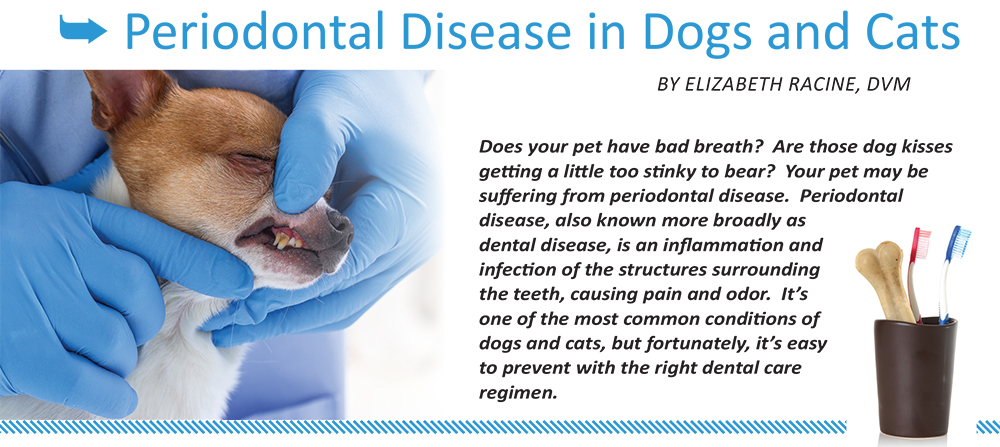WHAT CAUSES PERIODONTAL DISEASE?
Bacteria in your pet’s mouth form a slimy biofilm known as plaque on the teeth and under the gums. After about 24-48 hours, plaque begins to mineralize and harden, becoming tartar. As more plaque and tartar accumulate, your pet’s gums become inflamed, a condition called gingivitis. As the inflammation and infection progresses it affects the entire periodontium, which are the support structures surrounding the teeth. Left untreated, this can result in bone loss, jaw fractures, abscesses, and tooth loss. Bacteria can also be absorbed into the bloodstream and travel to other areas of the body, causing disease in major organs such as the heart, liver, and kidneys.
WHAT ARE THE SIGNS OF PERIODONTAL DISEASE?
The first symptom of periodontal disease most pet owners notice is bad breath. In many cases, this may be the only symptom that pet owners notice at home. Other symptoms of periodontal disease can include:
• Rubbing at the face or mouth
• Dropping food
• Excessive drooling
• Blood-tinged saliva
• Preference for softer foods
• Weight loss
If you notice these symptoms in your pet, it’s important to have them evaluated by your veterinarian. Periodontal disease is a progressive condition, so it will continue to get worse without appropriate treatment.
HOW IS PERIODONTAL DISEASE TREATED?
Unfortunately, once periodontal disease develops the only treatment is a professional dental cleaning under general anesthesia. Please do not be fooled by those who offer “anesthesia-free dentals” – these procedures are not only scary for your pet, but also do not address disease under the gum line, which is where the bulk of bacteria resides. In many cases, an anesthesia-free dental can do more harm than good. The only effective treatment for dental disease is a professional cleaning performed by a veterinarian. This should also include x-rays of your pet’s mouth to evaluate the extent of the disease and may include surgically removing the diseased teeth if necessary. Your veterinarian can further advise you on the procedure to be performed depending on the severity of your pet’s dental disease.
CAN PERIODONTAL DISEASE BE PREVENTED?
The good news is that periodontal disease can easily be prevented with a good at home dental care regimen and routine veterinary care. The best way to prevent periodontal disease is to brush your pet’s teeth daily. This prevents plaque from forming and stops periodontal disease before it starts. To brush your pet’s teeth, always use toothpaste that is specifically formulated for pets and never human toothpaste. If your pet will not allow brushing, prescription veterinary dental diets, dental treats,
and water additives can also help slow the progression of dental disease. Look for products labeled with the Veterinary Oral Health Council (VOHC) seal, which ensures that the product has been tested and shown to reduce plaque in clinical trials. And, of course, make sure your pet is receiving regular wellness check-ups with your veterinarian. Your veterinarian will often be the first person to spot the early signs of dental disease in your pet, and he or she can advise you on how best to address the disease and prevent further progression. ©

